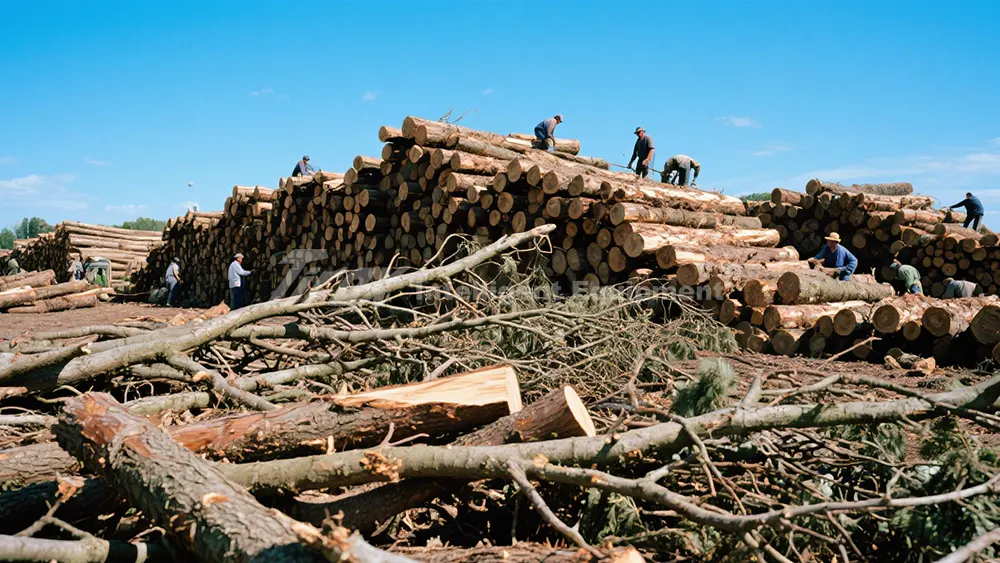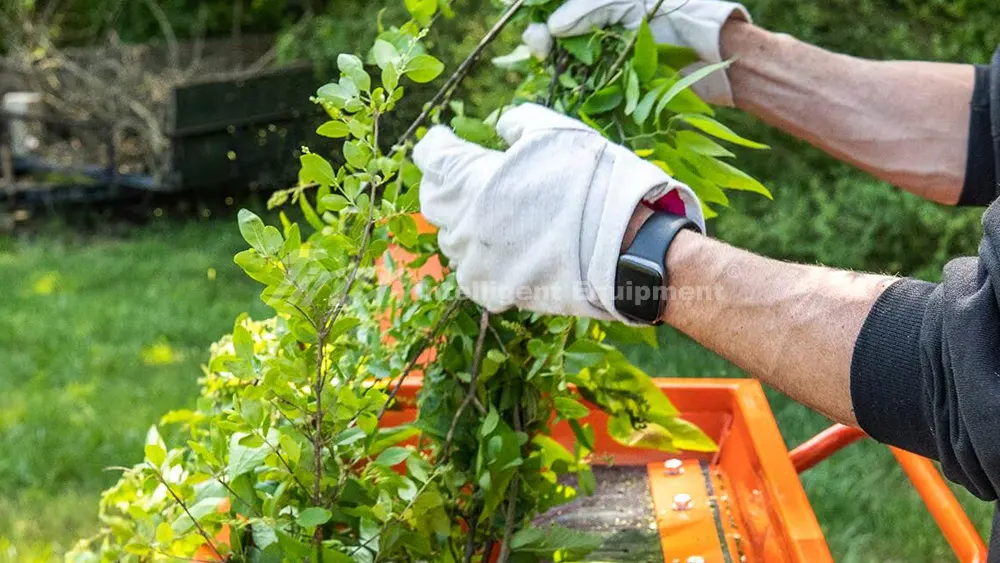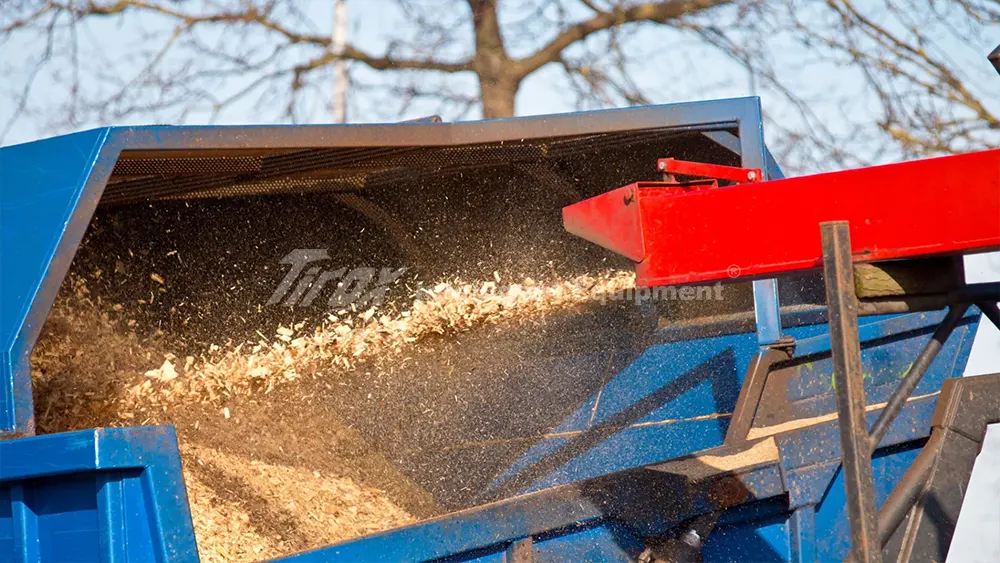Are you worried about what you can feed into your wood chipper? Putting the wrong materials in can ruin your machine and create serious dangers. Knowing what to avoid, especially metal like nails, is crucial for safe operation.
No, you should never put wood with metal, like nails, into a wood chipper. Even a small nail can cause significant damage to the chipper’s blades, lead to costly repairs, and create dangerous projectiles that can seriously injure operators or bystanders.
Now, let’s explore this topic in more detail. We’ll look at why certain materials are forbidden, what kind of wood can be chipped safely, and how thick wood a chipper can handle. My experience in this industry has shown me that understanding these basics is key to extending your machine’s life and ensuring everyone’s safety.
Can you put wood with Nails in a wood chipper?
You have wood with nails and wonder if your chipper can handle it. Ignoring this can lead to machine destruction and severe injury. Understanding the risks is essential before you even think about it.

Putting wood with nails into a wood chipper is strongly advised against. Metal objects, including nails, can cause catastrophic damage to the chipper’s blades, dull them quickly, and turn broken blade pieces into high-speed projectiles.
Why Metal and Other Prohibited Materials are Dangerous?
My years building these machines taught me that wood chippers are made for wood, and their blades are designed to cut organic fibers, not hard, non-organic materials like metal. When a metal piece, even a tiny nail, enters the chipper, it hits fast-spinning blades. This impact can cause the blade to break, and a broken piece of blade becomes like a bullet. It can shoot out of the machine at very high speeds. This poses an extreme danger to anyone standing nearby. Beyond just blades, the metal can damage other crucial components, like the internal metal plate called the anvil. Such damage leads to expensive replacement parts and labor. You can learn more about prohibited items in our blog post about what not to put in a wood chipper.[1]
The warning extends to all types of metal objects. It also applies to stones, plastic, glass, rubber, and fabric. Stones, for example, are hard. They will dull the blades rapidly. They can also break the blades or the metal plate called the anvil. Plastic doesn’t chip cleanly. Some types can melt from friction and gum up the internal workings. Other types shatter into sharp, hard-to-clean pieces. Moreover, treated or painted wood should also be avoided. It contains chemicals that can harm the machine and release toxins into the environment. Even large knots or materials exceeding the machine’s limits can cause blockages and strain the motor. Always remember, only clean wood and woody biomass are safe for these machines. Understanding these risks is part of crucial wood chipper safety.[2] For more general information about what a wood chipper is, you can check Wikipedia.[A]
| Material Type | Reason for Prohibition | Potential Damage/Hazard |
|---|---|---|
| Metal (Nails, Screws) | Not designed for non-organic material; blades are for organic fibers. | Blades: Catastrophic damage, dulling, breaking. Anvil/Other Parts: Expensive repairs/replacement. Safety: High-speed projectiles, severe injury. |
| Stones/Rocks | Hard and abrasive. | Blades: Rapid dulling, breaking. Anvil: Damage, expensive repairs. |
| Plastic | Doesn’t chip cleanly, can melt or shatter. | Internal Mechanism: Gumming up, clogs, malfunctions. Environmental: Not biodegradable, creates unprocessable waste. |
| Glass | Similar to stones, shatters dangerously. | Blades: Damage. Safety: Sharp projectiles, injury. |
| Rubber/Fabric | Can wrap around moving parts, not designed for chipping. | Mechanism: Entanglement, clogs, motor strain. Machine Damage: Overheating, breakdown. |
| Treated/Painted Wood | Contains chemicals and preservatives. | Machine: Harmful to machinery, potential breakdowns. Environment: Releases toxins. Output: Contaminated chips. |
| Excessively Large/Knotted Wood | Exceeds machine limits. | Motor: Increased strain. Machine: Blockage, damage. |

What can go through a wood chipper?
You need to process various wood materials efficiently. Using the wrong machine can lead to poor performance or damage. Knowing the proper materials for a wood chipper maximizes efficiency and safety.
Wood chippers are specifically designed to process clean wood and woody biomass, including branches, limbs, logs, and other untreated wooden debris, turning them into manageable chips. They are excellent for forestry, landscaping, and biomass production applications.
Acceptable Materials for Your Wood Chipper?
From my 22 years in the industry, I have seen that wood chippers, such as our general wood chippers, are built for processing organic wood materials. These machines excel at converting things like branches, limbs, and other untreated wood debris into chips. For example, our horizontal grinders—which are powerful wood processing machines—can handle tree branches and saplings up to 40 cm (around 16 inches) in diameter. They also process forestry waste like logging residues and piles of branches. These machines are also good for clean wood waste from construction or demolition, such as pallets and wood frames, if metal and plasterboard are pre-sorted. Green waste like garden pruning branches and shrubs, with a moisture content of 30% or less, are perfectly suitable. For biomass production, materials like palm empty fruit bunches and bagasse can be processed by adjusting the screen. Mixed waste from urban greening and old wooden furniture can also be processed if glass and stones are removed first.
For disc chippers, which are known for making uniform chips, suitable materials include bamboo (it works really well), hardwood and softwood logs (like oak, pine, eucalyptus), trunks, stumps with diameters up to the maximum feeding size, and wood processing waste like planks and wood scraps. They are also the best choice for biomass energy raw materials when you need uniform chips. Drum chippers are often better for messy branches. Our machines have a hydraulic forced feeding system that automatically adjusts based on the material diameter. This ensures optimal performance for different wood sizes. This system also incorporates an intelligent feeding system. It watches the crushing load and adjusts the feeding speed to stop blockages. This makes sure your work goes smoothly. Always consult our website to choose the right model.[3]
| Category | Specific Examples | Key Characteristics |
|---|---|---|
| Forestry Waste | Tree branches, limbs, trunks, stumps (within size limits). | Must be clean, untreated wood. Best for green, woody materials. |
| Green Waste | Garden pruning branches, shrubs, small trees. | Moisture content should ideally be less than 30% for horizontal grinders. |
| Clean Wood Waste | Untreated construction wood (e.g., pallets, wood frames, planks, wood scraps), old wooden furniture (without metal/glass). | Requires pre-sorting to remove non-wood contaminants like metal, plasterboard, glass. Free from paint or treatment. |
| Biomass Feedstock | Palm empty fruit bunches (EFB), bagasse, bamboo. | May require specific screen adjustments for optimal output. |
How thick can a wood chipper cut?
You have large branches or logs and need to know if your chipper can handle them. Overloading your machine with overly thick material can cause serious damage and inefficiency. Understanding the maximum cutting capacity of your wood chipper is essential for effective and safe operation.
The maximum thickness a wood chipper can cut depends on the specific model and its design. For instance, our models can process wood from approximately 18 cm (7 inches) up to 91 cm (36 inches) in diameter, depending on whether it’s a drum chipper, disc chipper, or horizontal grinder.
Understanding Wood Chipper Capacity?
From my 22 years of experience in manufacturing, I know that the cutting capacity of wood chippers varies greatly depending on the type and power of the machine. For instance, a common model can process wood up to 18 centimeters (about 7 inches) thick. However, when we talk about more robust machines like our horizontal grinders, their capacities are much larger. These can handle tree branches and saplings with diameters of up to 40 cm (around 16 inches) when equipped with a hammer-style rotor.
For specialized applications involving larger wood, our horizontal grinders with blade-style rotors are designed to process whole trees and stumps up to 91 cm (36 inches) in diameter. They can also take small trunks or cut logs up to 3 meters (nearly 10 feet) in length. This means that for different needs, there’s a specific machine. Choosing the right model involves considering the size of your raw materials and the amount you need to process daily or weekly. Our professional engineers always recommend the most cost-effective solution based on your specific material dimensions. The hydraulic forced feeding system, a key feature in our machines, adjusts its speed based on the material diameter. This allows our machines to optimize performance for different sizes of wood. This system helps us handle various diameters with ease. For example, a common inner feed port size might be 470x430mm, with an external feed port size of 1050x745mm. This shows the machine’s ability to take on sizable material. This adaptability ensures higher throughput and efficient processing for a range of wood sizes. You can discuss machine safety practices on relevant forums.[B]
| Machine Type | Primary Material Type | Max. Thickness/Diameter Capacity (Approx.) |
|---|---|---|
| Standard Wood Chipper (General) | Branches, limbs, small logs. | Up to 18 cm (7 inches). |
| Horizontal Grinder (Hammer Rotor) | Tree branches, saplings, forestry waste, clean construction wood, green waste, biomass. | Up to 40 cm (16 inches). |
| Horizontal Grinder (Blade Rotor) | Whole trees, stumps, large logs. | Up to 91 cm (36 inches) and logs up to 3 meters (10 feet) in length. |
| Disc Chipper | Bamboo, hardwood/softwood logs, trunks, stumps (requiring uniform chips). | Depends on specific model’s maximum feed size. Designed for large diameter wood due to larger disc inertia. |
It’s crucial to check the specific model’s specifications. Never exceed the stated maximum capacity. This will help you avoid damaging the machine or causing safety hazards. Always think about the hardness of the wood too. Harder wood puts more strain on the machine’s engine and blades. Our team can help you select the precise machine for your needs.[4]
Conclusion
In summary, while wood chippers are powerful tools, they are not designed for metal like nails. Only feed clean wood and woody biomass to ensure safety, prevent damage, and maximize efficiency.






